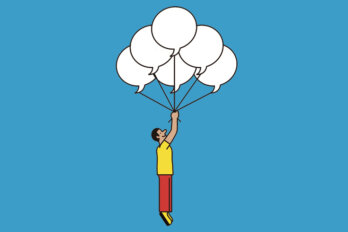In March, Mad Men actress January Jones posted an Instagram video of herself dancing while wearing a light-therapy mask—a hauntingly blank full-face plastic covering backlit by a blood-red glow. The mouth of the mask is open in a grimace, and through its massive eyeholes, Jones’s blue eyes are barely visible. Swaying her hips to the music, she inserts a straw into the mouth of the mask and begins to sip from the Coors Light can in her hand.
Jones is one of a handful of celebrities who’ve become Instagram stars while self-isolating—in her case, by embodying the weird, stir-crazy energy of being stuck at home. Her feed of mostly stylish, occasionally goofy photos took a definitive turn on March 18, when she posted a video of herself preparing a “detox bath” (“Human stew,” the caption reads)—containing, among other things, large quantities of baking soda—while wearing a goopy mud mask and a glittering sequined caftan. Since then, Jones has posted videos of herself peeling off a face mask; hula hooping in the yard to the music of The Weeknd; tap dancing badly, arms akimbo, while her dog looks on in confusion; and sweeping the floor in a feather-trimmed robe and Venetian mask.
Another celebrity whose Instagram has blown up under quarantine is Leslie Jordan. The Will & Grace actor’s shaky, close-up confessional videos, shot in the Chattanooga, Tennessee, Airbnb where he’s hunkered down near his family, have pushed his Instagram following over 4.5 million. Some of Jordan’s videos start with him saying, “Well, shit,” in his flat pillow of a drawl, followed by rambling explanations of his attempts to stave off boredom—painting each toenail a different colour to honour front line workers, say, or watching porn while eating a breakfast sandwich. Elle has dubbed the sixty-five-year-old “the breakout star of quarantine.”
The trending-celebrity horse race mirrors our collective priorities—in dark times, people want to laugh; when the world seems out of control, we cling to the ridiculous. But it was one thing to see my acquaintances start sharing Jones and Jordan’s posts and quite another to see those posts filter into mainstream, even highbrow culture coverage. “He narrates his life with the same laconic derangement that is gripping all of us,” Elle rhapsodizes about Jordan’s videos, “creating mini-dramas out of the mundane and barely blinking at the extraordinary.” The New Yorker goes even further, suggesting that “the coronavirus crisis has dampened the public’s appetite for a certain kind of celebrity—the polished and composed type, looking to preach or inspire. It’s the unvarnished eccentrics who shine, the ones who are cooped up, losing their marbles, but still hell-bent on entertaining.” In other words, Leslie Jordan is all of us.
The currency of fame has always been deeply unstable. But, with movie theatres and live venues closed and the devices in our pockets quickly becoming our primary media machines, it can feel as though famous people are suddenly on the same footing as everybody else. Despite this illusion of a level playing field, many people are still holding on to stardom as a meaningful category, as something that validates their experiences of isolation. It’s not enough, it seems, to see our feelings reflected by friends and family—there’s further comfort in having those feelings amplified through the conduit of celebrity. But partaking in this comfort isn’t always free.
Across platforms, famous faces are appearing in unfamiliar ways—not slick, not produced, a little silly. Even projects that strive to be more polished—like John Krasinski’s YouTube channel, Some Good News, where he posts segments “dedicated entirely to good news”—feel overly intimate, almost uncanny. It’s weird to see Krasinski or a late-night host or the cast of Saturday Night Live against the backdrop of their own living spaces. This feeling tips into second-hand embarrassment in the case of the quarantine’s ultimate failure of celebrity relevance: the Gal Gadot–led singalong to John Lennon’s “Imagine.” People didn’t appreciate seeing stars, self-isolating in mansions, urging us all to “imagine no possessions.” Attempts like Gadot’s reflect pure narcissism, an ill-fated attempt to be political. But other stars are capitalizing on our hunger for celebrity mirrors in an all too familiar way: as opportunities to increase cash flow.
Like ordinary people worldwide, celebrities have found themselves with reduced incomes. A growing number of artists have turned to platforms like Cameo, an app through which anyone can solicit a personalized video message from a famous person—whom Cameo calls “talent”—for a price set by the celebrity. In the first two weeks of the US’s social distancing measures, Cameo requests reportedly spiked, jumping up to around 4,500, on a single day, from the usual average of 1,000 to 2,000. The app saw a rush of higher-profile celebrities joining its ranks, and the average price of a Cameo video actually dropped—perhaps due to the demand. Stars’ reasons for joining the platform vary. Some do so with the explicit mission of raising money for COVID-19 relief. For others, there is no mention of where the money goes, making the messages akin to picking up Uber fares in your off time—the gig economy for the elite.
If you shell out $295, Sean Astin—Samwise Gamgee from The Lord of the Rings—will send your best friend a happy birthday message, but David and Annie, a couple from 90 Day Fiancé, will do it for just $37. More than just a reflection of our feelings of isolation, celebrities can be our mouthpieces—but only, of course, if we’re willing to pay.
Scrolling through the interface, the user sees actors and musicians and reality stars’ headshots tiled like the contents of a streaming service. Each one has a small price tag in the corner. (Dolph Lundgren, $250; the drummer for One Direction, a surprising bargain at $25.) Users who purchase a video can leave a review, and each celebrity has a ranking out of five stars and snippets of reviews on their profile. The baldly transactional nature is astonishing, especially in a time when so many people’s incomes have plummeted.
But the underlying concept is not exactly new. For a long time, fans have been willing to pay for a fleeting moment of connection with their favourite stars—famous people used to do the same sort of thing in person at meet-and-greets. Even though so many more fundamental things about our lives have changed, this desire to touch fame persists.
On celebrities’ Cameo pages, you can view their most recent videos as a sample of the wares you might purchase. On Carson Kressley’s profile, I found a row of nearly identical thumbnails (it’s popular, and presumably cost-effective, for the “talent” to knock out a few videos in a row): the former Queer Eye star wearing a green zip-up sweater, sitting on a yellow chair in a dimly lit room with a baby grand piano in the background as he delivers his messages. Something about these affable addresses seemed so human that I found myself warming up to the whole project. Sure, it’s shamelessly transactional, but maybe this is making people happy. That’s worth something, isn’t it?
It’s hard to look past the shallowness of the entire endeavour, though, the emptiness and even exploitativeness of celebrity at a time like this. If there is a right way to be a wealthy person during a worldwide crisis, this isn’t it—surely it is closer to the actions of those celebrities using their platforms and means for charitable aid. Rihanna’s foundation, for instance, has donated $5 million (all figures US) to various organizations providing COVID-19 relief and given $2 million to help women at risk of domestic violence during the lockdown. Lady Gaga organized a benefit concert for the World Health Organization (WHO) and helped raise $55 million for the WHO’s COVID-19 Solidarity Response Fund as well as $72.8 million for other charities. Other celebrities, from Kylie Jenner to Jay-Z, have also thrown their wealth behind the cause—though the need for these donations raises questions about why funding public health falls to pop stars and influencers rather than to national governments.
Perhaps asking what celebrities should do is the wrong question, and the real problem is celebrity’s outsize influence on our social world. The pandemic has exposed the dark side of the narcissism fame and money bring—Vanessa Hudgens apologized for a live video in which she called deaths from the virus “inevitable.” (She was mad about the possibility of not being able to go outside until July.) Evangeline Lilly drew the ire of the internet with a social media post, captioned “#businessasusual,” that seemed to suggest she was rejecting social distancing measures by taking her kids to a gymnastics camp. This ignorance requires a level of privilege, a sense of insulation from the possibility of harm, that most people just don’t have—especially those workers deemed essential, who don’t even have the luxury of staying home.
One person’s bad takes wouldn’t matter so much if that person weren’t so venerated and given such a large social platform. Our shared obsession with famous people demands that they respond in socially appropriate ways because of the role we’ve cast them in: both mirror and model for our ideal selves.
The pandemic has thrown our preexisting inequalities into relief: we are all facing the same threat, but we have very different resources at our disposal with which to cope. Usually, in a crisis, resources would flow toward the affected area; with the pandemic spanning the entire globe, the project of charity becomes more like wealth redistribution. The bottom has fallen out of the elements of capitalism that we were taught were immutable—supply and demand, or the intrinsic value of things like money and oil. Celebrity looks different too, especially as physical distancing measures threaten what stars are ostensibly famous for: acting, making music, starring in reality shows.
Life under quarantine often feels like ping-ponging back and forth between the dire and the trivial. As the pandemic continued to worsen, my social media timelines were an odd patchwork of news reports and sourdough starters. For once, scrolling through the frenetic Twitter algorithm accurately mirrored what was going on inside my brain. At any given moment, the open tabs on my browser might contain both the worldwide death toll and a deep-dive Google-search attempt to find an open bakery that will deliver me an almond croissant.
If we possess some kind of limited capacity for grief, perhaps the continued existence of celebrity in a time of crisis is proof positive. One night, I was sitting on my couch, listlessly refreshing my social media feeds, my thumb moving of its own accord. There was nothing I had not yet seen. Well, I’ve read the whole internet, I thought. Maybe I’ll see what January Jones is up to.






